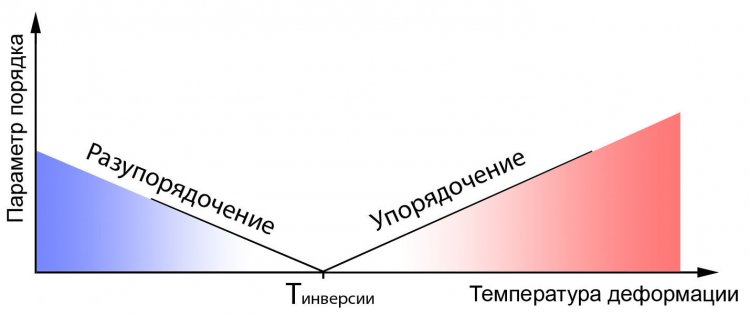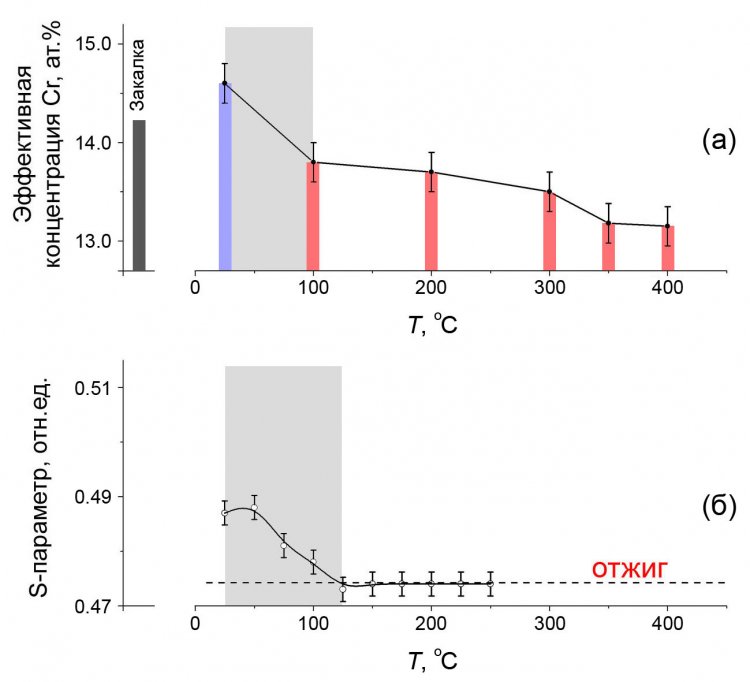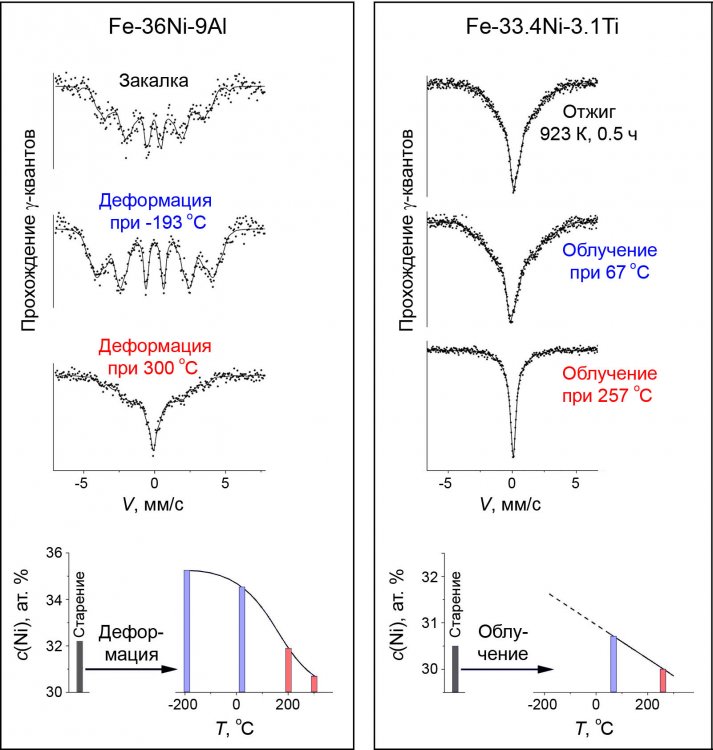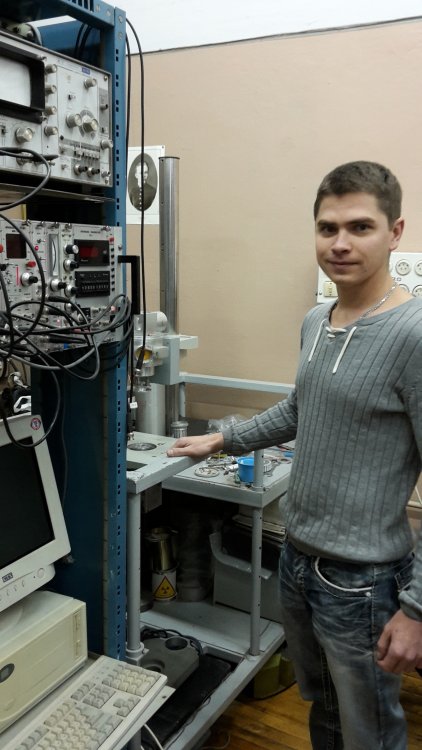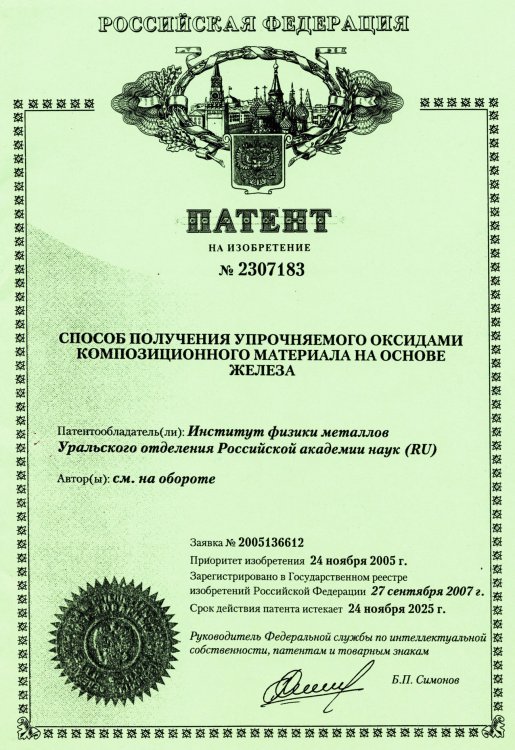Physicists-experimenters from M.N. Mikheev Institute of Metal Physics of the Ural Branch of the Russian Academy of Sciences (IMP UB RAS), Yekaterinburg, are using Mössbauer’s method to identify the main patterns of phase transformations at the atomic level in iron alloys and compounds, which occur during exposure to intense deformation. The results help develop physical frameworks for creating new nanocrystalline material with improved physical-mechanical properties.
New materials with special physical properties that the industrial sector and metallurgy need so much (e.g., heat-resistance reactor steel) are created using intense cold (low-temperature) plastic deformation (ICPM). However, the so-called shear and diffused structural phase transitions of atoms in the alloys and compounds being investigated have to be taken into account. Experimental research helps monitor the structure formation. On submicron and nano levels, this makes it possible to detect redistribution of atoms, participation of defects, composition irregularities and high stress in the structure.
Specialists of the Institute of Metal Physics are presenting new experimental data that uncover the mechanism and patterns of phase and structural transformations that occur during the course of ICPM in iron alloys and compounds. In addition, the scientists are developing a more cost-efficient steel nitriding technique for the production sector, and investigating what happens to nitrogen-containing materials exposed to extreme deformation load.
The specialists of M.N. Mikheev Institute of Metal Physics of the Ural Branch of RAS (IMP UB RAS ), Yekaterinburg – Valeriy Aleksandrovich Shabashov, Doctor of Physico-Mathematical Sciences, senior research officer at the Mechanical Properties Laboratory, and Kirill Aleksandrovich Kozlov, Candidate of Physico-Mathematical Sciences, senior research officer at the Mechanical Properties Laboratory – described the deformation impact and ageing methods, their effect on substitution alloys, and how deformation affects alloys with a high content of interstitial elements, and how steel nitrides and composites are synthesized, which allows modifying structures and creating metal materials with unique functional properties.
“In fundamental physics, the size effect is vital, as it determines laws of physics, e.g., laws of classical mechanisms (for macro systems) and quantum mechanics (for micro systems). In modern material studies, scientists and engineers are focusing on physical effects associated with structure elements being reduced to the nano level. Superhigh plastic deformation (deformations) is one of the methods of producing nanocrystalline materials. The physical principles of deformation-based reduction of metal materials to submicron and nano sizes were described in works of Russian scientists, such as V.V. Rybin, A.M. Gleizer, M. A. Shtremel, V. V. Sagaradze, Y. N. Gornostyrev, etc.
In particular, A. M. Gleizer et al. formulated some physical principles of the evolution of the structure of metal materials exposed to superhigh (mega) plastic deformation at temperatures Т <0.3Тmelting. The very term mega-plastic deformation was defined as a condition whereunder dissipation of high mechanical energy by a system cannot be effected through dislocation motion, and other relaxation channels of mechanical energy become involved, such as dynamical recrystallization, diffusion, etc.
The cycle of works presented covers the processes of atomic mass transfer under the conditions of reduction of structure elements (grains), induced by superhigh plastic deformation. Within the classic understanding of the laws of normal diffusion, the participation of thermally activated processes of atomic diffusion redistribution in the crystal structure of iron alloys at near room temperatures is negligible. Plastic deformation including with high degrees, has little effect on diffusion at room temperatures, especially in substitution alloys. Moreover, where deformation temperatures are relatively low, disordering, atomic mixing and amorphization (structures such as solid quasi-glass) processes prevail, which is a manifestation of mechanical alloying mechanisms. Amorphization is loss of translation symmetry and the unit cell in the crystal due to nonequilibrium shear structural transitions and diffusion flows.” Valeriy Shabashov, Doctor of Physico-Mathematical Sciences, explained in detail the significance of information (in particular, experiment-based data from IMP scientists) on research on the patterns of low-temperature phase transformations in iron alloys and compounds being exposed to extreme deformation loads, for basic science.
–
During the course of our works of the last 5 to 7 years on the binary substitution alloys Fe–Cr, Fe–Mn, Fe–Ni and the trenary alloys Fe–Ni–Me (Ti, Al), we found that within a relatively narrow temperature range somewhat above the room temperature (close to 100 ◦С), under the conditions of superhigh plastic deformations ε > 3, the direction of atomic redistribution changes from the processes of disordering and dissolution of disperse particles of intermetallics with cold deformation, to accelerated ordering and decay of solid metal solutions, with creation of secondary nanocrystalline phases (see Image 1). The deformation-induced decay and ageing processes detected accelerated processes that share patterns with radiation-accelerated processes, e.g., accelerated radiation with high-energy electrons or fast neutron in a close temperature range.”
Image 1. General schematic of atomic order change depending on temperature of superhigh deformation of pre-aged iron alloys.
What are ageing and non-ageing alloys?
«The mechanism of ageing deformation of alloys is known. Ageing mostly occurs with involvement of interstitial impurity, both during the maturing (static) and within the process of the deformation itself (dynamic). The mechanism is about creating atmospheres of dopant atoms and then interstitial phases at dislocations and grain boundaries (structures of the atoms),” Kirill Kozlov explained.
What is dynamic ageing and under what alloy deformation conditions can it be observed?
“We have observed dynamic ageing in substitution alloys in a temperature range close to room temperature, as we were working with concentrated binary iron alloys. When deformation occurs at temperatures just above the room temperature, one can observe short-range ordering in binary concentrated iron alloys, and accelerated decay with creation of dispersed secondary intermetallics – in the trenary alloys Fe–Ni–Me (Ti, Al),” the young scientist clarified.
Which mechanical activation technique is the most effective?
“We used pressure shifting in Bridgman anvils, grinding in ball mills, and sliding friction as methods to produce superhigh plastic deformation (see Image 2).
Image 2. Schematic representation of deformation impact methods.
In terms of obtaining physics information on the principles of structural phase transitions caused by mechanical activation, the most effective method is pressure shifting in rotating Bridgman anvils. This method allows control over physical parameters, such as degree, speed and temperature of deformation. Moreover, superhigh levels of plastic deformations in Bridgman anvils don’t destroy the sample. In many ways, pressure shifting is a model method as regards practically important methods of deformation impact, such as dry sliding friction, equal channel angular extrusion, processing in ball mills, etc.,” Kirill Kozlov replied.
The scientists are conducting their experimental work at IMP UB RAS (Yekaterinburg), with participation of colleagues from the Institute of Electrophysics of the Ural Branch of the Russian Academy of Sciences (IEP UB RAS), Yekaterinburg, the Institute of Solid State Chemistry of the Ural Branch of the Russian Academy of Sciences (ISSC UB RAS), Yekaterinburg, A.A. Bochvar High-Technology Scientific Research Institute for Inorganic Materials (VNIINM), Moscow, and the National Research Nuclear University (MEPHI), Moscow.
The Ural physicists are investigating the substitution alloys Fe–Cr, Fe–Mn, Fe–Ni, Fe–Ni–Me (Ti, Al) and manifestations of dynamic ageing activity in them.
“The alloys are metastable and undergo ordering and decay when subjected to prolonged thermal treatment or radiation with high-energy particles. In this respect, binary alloys are a good model material for investigating abnormal (in terms of speed and temperature) diffusion processes. These studies compared the kinetics of dynamic ageing with diffusion-accelerating radiation impact caused by radiation with high-energy electrons and fast neutrons). These works were based on the idea that superhigh plastic deformation and radiation generate point defects of high density.
In particular, work has been done on inversion of short-range order parameter in the deformation temperature range from room temperature up to 100◦С (see Image 3). Combination Mössbauer spectroscopy and positron annihilation methods showed that the cause of dynamic ordering is generation of mobile vacancy complexes involved in diffusion processes. It was also shown that the main condition for accelerated dynamic ordering is continuous generation of mobile point defects over the time of deformation impact for several minutes (with thermal annealing, the close degree of ordering is achieved by soaking for dozens of hours). Accelerated kinetics of dynamic ageing can be compared to the accelerating effect of radiation with high-energy electrons and fast neutrons. Involvement of point defects (vacancies and interstitial atoms) was analyzed at an early stage of phase transitions in the form of short-range order destruction and creation processes (see Image 3) and dissolution and isolation of nitrides in ageing Fe-Ni-Me (Ti, Al) (see Image 4).
The patterns detected in the effect of superhigh plastic deformation on development of transitional temperature range in the mechanism and kinetics of phase transitions in substitution alloys were also demonstrated in interstitial alloys – nitrogen supersaturated ageing Cr–Mn austenitic steels and high-carbon Fe–Ni steels. It was shown that ageing (yield of nitrogen and chromium elements into nitrides) increases with temperature and deformation degree, which indicates the dynamic nature of the ordering mechanism operating under deformation impact conditions,” Valeriy Shabashov detailed.
Image 3. Effective concentration of chromium (characterizing the order parameter) and S-parameter (characterizing the mobility of vacancy complexes), depending on deformation temperature (а) and thermal annealing of the alloy Fe–16Cr subjected to radiation with electrons (b).
Image 4. Mössbauer spectra and change in nickel concentration (Ni) in face centered cubic (FCC) matrices of aged steels Fe-Ni-Me (Al, Ti), resulting from dissolution and separation of intermetallic γ´-phase (Ni3Al and Ni3Ti) in response to deformation and radiation with neutrons with fluence of 1020 cm-2 at various temperatures.
Why do you use Mössbauer spectroscopy methods to investigate deformations in iron and alloys?
Kirill Aleksandrovich Kozlov, Candidate of Physico-Mathematical Sciences, senior research officer at the Mechanical Properties Laboratory of M.N. Mikheev Institute of Metal Physics of the Ural Branch of the Russian Academy of Sciences. Photo: Mössbauer Spectrometer.
“Mössbauer spectroscopy is a probing method, where the natural probe – a Fe57 atom in iron-bearing phases provides information on nonequivalent conditions (positions) of the Mössbauer probe in iron-bearing phases. This information (on crystal, magnetic, electronic, and phonon structure) is generated on local level 1–2 of the coordination sphere in relation to iron. Information based on Mössbauer spectroscopy data allows observing processes of atomic redistribution of alloying elements, order changes and phase transitions at local atomic level, and getting information from the entire sample. What is important is that with Mössbauer spectroscopy, there are no restrictions caused by dispersion of structural elements (amorphous structure, nanocrystalline phases, clusters, short– and long-range order elements), or distortions of the crystalline lattice, caused by strong plastic deformation. Aside from the transmission option, the advantage of the probing method is the fact that it is possible to examine the structure in the surface of layers modified by deformation/radiation (conversion electron method) or on developed grain boundaries in nanostructure (emission Mössbauer spectroscopy). Other analysis methods have been applied in addition to Mössbauer tests: electron microscopy, X-ray structural analysis, etc.,” Kirill Kozlov explained.
How does superhigh plastic deformation affect alloys that contain a lot of interstitial elements – carbon, nitrogen, oxygen?
“The studies of abnormal behaviors in response to deformation of structural phase transformations in substitution phases were continued with interstitial alloys and steels, e.g., in the austenite FeNi36C oversaturated with carbon and in high-nitrogen Cr–Mn steels (FeMn22Cr18N0.83 и FeCr22Mn1.4N1.24). Using Mössbauer spectroscopy, electron microscopy, and mechanical tests in high-nitrogen chromomanganese steel FeMn22Cr18N0.83 we found the narrow temperature range (from room temperature up to 100◦С) wherein the mechanism and kinetics of structural phase transformation change in the process of mechanical alloying under the conditions of deformation in rotating Bridgman anvils (see Image 5).
Image 5. The kinetics of mechanical alloying with nitrogen (а) and the hardness (b) of steel FeMn22Cr18N0.83 depending on temperature of deformation (ε = 5) by pressure shifting.
The temperature range found is characterized by a change of direction of nitrogen redistribution from increasing content in the metal matrix with cold (20◦С) deformation to accelerated decline in response to increased temperature (100◦С or higher) and degree of plastic deformation (> 4). The change in the direction of nitrogen redistribution is caused by abnormal acceleration of decay processes in the nitrogen-oversaturated solid austenite solution in a complex competition of processes of dislocation dissolution and dynamic ageing, with generation of secondary nanocrystalline nitrides. The existence of a transitional area in the mechanism of structural phase transitions manifests itself in the abnormal behavior of mechanical properties of steel due to development of age hardening,” Valeriy Shabashov commented.
During the course of deformation-induced phase transformations, the scientists of the Institute of Metal Physics produced high-nitrogen nanocomposites and proposed their original approach to solid-phase mechanical synthesis of steel nitrides and composites.
According to Kirill Kozlov, “the new approach to creating nitric (carbonaceous, oxide) composites is deformation-induced cyclical phase transformations of mixtures according to the scheme (see Image 6). The first work on mechanical alloying with cyclical, deformation-induced phase transitions was performed with У13 steel [V. A. Shabashov et al. Material Science and Engineering 2003]: deformation dissolution was observed at room temperature of the carbide Fe3C in the iron matrix, with generation of secondary solid solutions α and γ Fe–C and Hägg and Hoffer carbides. The first work on solid-phase mechanical alloying of metals with oxygen was performed in 2005, with hematite as the oxygen donor. The idea of using solid-phase mechanical synthesis of iron-based composite materials strengthened by carbides and oxides was continued as the method of alloying metal and alloys with nitrogen was created.”
Image 6. The key diagram of the approach to creating composite materials that was applied in the cycle of works presented.
Somewhat earlier, Valeriy Shabashov, Doctor of Physico-Mathematical Sciences, investigated the solution involving the use of iron and copper oxides to study the patterns of deformation of metals and alloys. As a result, the scientist was issued the patent “Technique for producing iron-based composite material strengthened by oxides”. According to the author, “the essence of the method of using solid-phase mechanical synthesis to produce iron-based composite material strengthened by oxides is in the deformation dissolution (with the use of ball mills, pressure shifting, and friction impact) of unstable iron oxides (Fe2O3, Fe3O4, CuO) in a matrix of alloys doped with oxide-generating elements (Y, Ti, Zr, Al, etc.), with subsequent generation of secondary strengthening oxides such as Y2O3, Y2TiO5, TiO2, Al2O3, etc. in the matrix (directly during the course of deformation or during subsequent thermal annealing).
Image 7. Patent. Photo from the archive of V. Shabashov
The proposed method was also applied to produce high-nitrogen nanocomposites. The nitrides CrN (Cr2N), Mn2N (produced by self-propagating thermal synthesis) and the nitrides Fe4N and CrN (Cr2N) on the surface of the alloys (produced with the use of ion-plasmous nitriding) were used in the synthesis in ball mills as nitrogen donors. Nitrogen is recommended for synthesis of austenitic composites (based on non-magnetic gamma-phase) since nitrogen with high concentration (similar to carbon) in a solid solution stabilizes the high-temperature γ-phase. The studies produced sub-microcrystalline nitrogen austenite strengthened by secondary nitrides in powders and on the surface of pre-nitrided steels and alloys.
The solid-phase mechanical nitriding allows substituting nitrogen for the expensive doping elements Ni and Mn in order to produce austenitic steels.”
Where could your new data on deformation conditions and atom structure on the nano level be used?
“The new data on evolution of the structure of steels and alloys in response to deformation impact could be used to create new techniques using cold and warm plastic deformation in order to produce a modified structure with improved user properties, and to create nanostructured alloys and nanocomposites. Experiments with pressure shifting in comparison with experiments with sliding friction could be used to choose friction impact mode in order to control the structure of surface layers of alloys and steels, from nanostructured solid solutions of interstitial and substitution elements to alloys and steels strengthened with secondary dispersed phases (nitrides, oxides, carbides). The studies on solid-phase mechanical nitrogen doping would help replace the expensive Ni and Mn with nitrogen in austenitic steels. Moreover, the technique of solid-phase synthesis in ball mills is considerably cheaper than the traditional metallurgical smelting of nitric steels with nitrogen counterpressure,” Valeriy Shabanov outlined.
Has the method you are proposing been tested in metallurgy or in the industrial sector?
“The method for creating three-dimensional pieces of steels dispersion strengthened with oxides (steels that could be used in the nuclear industry and other sectors) has been tested at A.A. Bochvar High-Technology Scientific Research Institute for Inorganic Materials (VNIINM), Moscow, and the National Research Nuclear University (MEPHI), Moscow, with application of various compacting technologies. Materials produced using the proposed technique have superior strength parameters and could be useful in the manufacturing sector,” Valeriy Shabashov, chief research officer of the at UMP Mechanical Properties Laboratory, believes.
The experimental data produced by the Yekaterinburg specialists open new possibilities in regulating the conditions of intense plastic deformation and analysis of atomic structure, which are important for creating advanced technical processes and materials.
All photos and pictures are provided by Valeriy Shabanov and Kirill Kozlov
Photo prew gl0ck33
